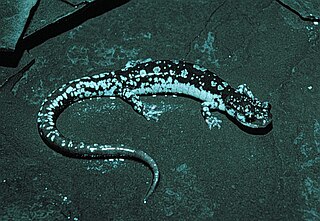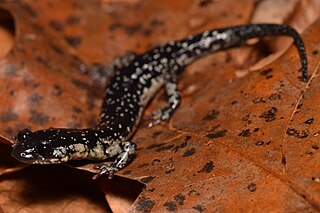
Plethodon is a genus of salamanders in the family Plethodontidae. They are also known as woodland salamanders or, more rarely, slimy salamanders. All members of the genus are endemic to North America. They have no aquatic larval stage. In some species, such as Plethodon cinereus, the red-backed salamander, eggs are laid underneath a stone or log. Young hatch in the adult form. Members of Plethodon primarily eat small invertebrates. The earliest known fossils of this genus are from the Hemphillian of Tennessee in the United States.

The red-backed salamander is a small, hardy woodland salamander species in the family Plethodontidae. It is also known as the redback salamander, eastern red-backed salamander, or the northern red-backed salamander to distinguish it from the southern red-backed salamander. The species inhabits wooded slopes in eastern North America, west to Missouri, south to North Carolina, and north from southern Quebec and the Maritime provinces in Canada to Minnesota. It is one of 56 species in the genus Plethodon. Red-backed salamanders are notable for their color polymorphism and primarily display two color morph varieties, which differ in physiology and anti-predator behavior.

The northern slimy salamander is a species of terrestrial plethodontid salamander found throughout much of the eastern two-thirds of the United States.

The Cheat Mountain salamander is a species of small woodland salamander found only on Cheat Mountain, and a few nearby mountains, in the eastern highlands of West Virginia. It and the West Virginia spring salamander are the only vertebrate species with geographic ranges restricted to that state.

Dunn's salamander is a species of salamander in the family Plethodontidae endemic to the western United States.

The Del Norte salamander is a species of salamander in the family Plethodontidae endemic to the United States in southwestern Oregon and northwestern California.

The Fourche Mountain salamander is a species of salamander in the family Plethodontidae endemic to the Ouachita Mountains in the central United States. Its natural habitat is temperate forests and it is threatened by habitat loss.

The Peaks of Otter salamander is a species of salamanders in the family Plethodontidae. It is endemic to the Peaks of Otter area in the Blue Ridge Mountains of Virginia. It is a montane salamander found at elevations above 442 m (1,450 ft), but more commonly above 760 m (2,490 ft). It can be locally common, but its distribution is small and patchy. This makes it vulnerable to local threats such as timber harvesting, recreational development, defoliation by gypsy moths, and spraying to control the latter.

The Cumberland Plateau salamander is a species of salamander in the family Plethodontidae. It is endemic to the Cumberland Plateau, the southeastern United States. Its natural habitat is temperate forests. It is threatened by habitat loss.

The northern gray-cheeked salamander is a species of salamander in the family Plethodontidae and endemic to the Blue Ridge Mountains and Appalachian Mountains in the eastern United States. It is closely related to the Red-cheeked salamander and the Red-legged salamander. Its natural habitat is temperate forests. It is found under moss, rocks, logs, and bark in cool, moist forests above 2500 feet. Especially found in spruce-fir forests. The Gray-cheeked Salamander commonly eats millipedes, earthworms, crane flies, spiders, and centipedes and less commonly eats ants, mites, and springtails. They eat spiders, moths, flies, beetles, bees, and snails. The male and female perform a courtship, where the male nudges the female with his snout, does a foot dance, then circles under the female and the two then walk together. It is threatened by habitat loss.

The Rich Mountain salamander is a species of salamander in the family Plethodontidae. It is endemic to the Ouachita Mountains in western Arkansas and eastern Oklahoma. Its natural habitat is temperate forests. It is threatened by habitat loss.

The Cow Knob salamander, also known as the white-spotted salamander, is a species of salamander in the family Plethodontidae. It is endemic to the United States. It is found on Shenandoah Mountain, Nathaniel Mountain and Great North Mountain in eastern West Virginia and western Virginia. Most of its known locations are in the George Washington National Forest.

The Shenandoah salamander is a small, terrestrial salamander found exclusively in Shenandoah National Park in Virginia. The Shenandoah salamander inhabits a very small range of land on just three mountain peaks. Due to the small habitat range, interspecies competition, and climate change, the population of the Shenandoah salamander is vulnerable to extinction. Mitigating human effects on the habitat of the species will be essential in attempting to preserve and grow the population

The Big Levels salamander is a species of salamander in the family Plethodontidae. It is endemic to Virginia in the eastern United States. First described in 2004, it derives its specific name, sherando, from Sherando Lake in the George Washington National Forest. Its common name refers to the Big Levels area of southeastern Augusta County, Virginia, a series of flat to gently rolling mountain tops in the Blue Ridge Mountains, where it was found.

The red-legged salamander is a species of salamander in the family Plethodontidae. Formerly considered a subspecies of Plethodon jordani, it is native to the mountain forests of the southeastern United States.

The Webster's salamander is a species of salamander in the family Plethodontidae. It is endemic to the southeast United States, in patchy and disjunct lowland subpopulations ranging from South Carolina to Louisiana. Its natural habitat is mixed mesophytic temperate forests, in association with rocky streams and outcrops.

Weller's salamander is a species of salamander in the family Plethodontidae. This species in endemic to the southeastern mountain range of the United States. It is mainly found in North Carolina near Grandfather Mountain. The salamanders have a unique metallic spotting which distinguishes them from other Plethodon species and other salamanders in the area. They mainly inhabit cool forests with rocky areas.

The Yonahlossee salamander is a particularly large woodland salamander from the southern Appalachian Mountains in the United States. The species is a member of the family Plethodontidae, which is characterized by being lungless and reproductive direct development. P. yonahlossee was first described in 1917 by E.R Dunn on a collection site on Grandfather Mountain in North Carolina. The common and specific name is of Native American origin, meaning “trail of the bear”. It is derived from Yonahlossee Road northeast of Linville, where the specimen was first described.
The Ocmulgee slimy salamander is a species of salamander in the family Plethodontidae. It is endemic to the state of Georgia in the United States, where it is found in regions of the coastal plain and Piedmont that are associated with the Ocmulgee River drainage system. It is only known from a few counties, and due to this restricted range, it is at high risk of extinction. Many populations of this species are already experiencing precipitous declines, with some even possibly being extirpated.


















